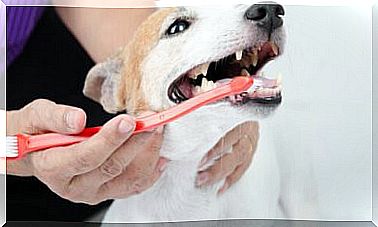Acute Abdomen In Dogs: What Is It?

The acute abdomen in dogs can cause a lot of pain and is usually associated with diseases such as canine peritonitis. Early diagnosis is crucial to apply the effective and immediate treatment that the condition requires. Therefore, we invite you to learn more about acute abdomen in dogs, its symptoms and causes.
Acute abdomen in dogs: what it is and how it develops
The acute abdomen is generally considered more of a complex symptom than a pathology in itself. It consists of a picture of symptoms that includes clinical signs. They are acute pain, diarrhea, bloating, vomiting, malnutrition, weakness, depression, etc.
As we can see, the acute abdomen in dogs is almost always associated with diseases that compromise the abdominal cavity. Among them, the one that most affects animals of all ages is canine peritonitis.

However, in some cases, the acute abdomen appears as a consequence of the worsening of certain chronic diseases of the abdominal organs.
What is canine peritonitis?
Peritonitis is an acute, sudden inflammation that occurs in the tissues that make up the abdominal cavity (or peritoneum). As a result, the body accumulates an enormous amount of fluid in the peritoneal region, which causes noticeable swelling.
This intense fluid retention also causes severe dehydration and electrolyte imbalance. This reaffirms the need to be aware of the symptoms and immediately go to the vet to diagnose them in your pet.
Canine peritonitis usually starts and progresses very quickly in the body. Many animals arrive at the veterinary clinic in a state of shock or coma. In these cases, before proceeding with the diagnosis, it is very likely that the veterinarian will immediately start anti-shock therapy.
Acute Abdomen Symptoms in Dogs
The first visible signs of acute abdomen in dogs may not be very specific, but they are easy to recognize. At first, the animal is constantly tired, breathing more heavily, and its appetite is reduced. Afterwards, he may shiver and permanently cry or moan because of the pain he feels in his abdomen.
The following symptoms are associated with the advancement of peritonitis in the animal’s body:
- Lethargy
- Changes in posture and in the way of lying : it is common for dogs to try to find a position where the pain is less bothersome.
- Abdominal swelling and/or tight abdomen.
- Acute Pain : Many dogs can cry in pain with a simple touch or when rubbing their abdomen somewhere.
- Diarrhea : normally black in color (with melena).
When inflammation compromises the intestines and stomach, it often causes frequent vomiting. In addition, many dogs also have a fever.
As with most pathological conditions, symptoms of canine peritonitis are aggravated by disease progression. In many cases, animals come to the vet in shock.
Thus, the urgency of early diagnosis is essential to allow an effective treatment and avoid serious complications. It is essential to contact your veterinarian immediately if you notice any of the symptoms described above.
Causes of Acute Abdomen in Dogs
Most acute abdomen diagnoses in dogs are related to endogenous and infectious causes, such as:
- Viruses affecting the stomach and/or intestines
- “Intestinal flu” (or viral gastroenteritis)
- canine peritonitis
- Intestinal or stomach endoparasites
- Uterine infection (usually bacterial)
- Presence of holes in the stomach or intestines
- Abscesses (or accumulation of pus) in the spleen, liver, pancreas or intestines
Non-infectious causes of acute abdomen in dogs
Many dogs can have an acute abdomen due to non-infectious or exogenous factors, such as:
- Poisoning
- certain types of tumors
- Congenital diseases or deformities
- Trauma in the abdominal region
- abdominal hernia
- gastric dilation
- Kidney or Gallbladder Stones

Treatment of acute abdomen in dogs
The specific treatment should be determined by the veterinarian, after diagnosing the cause of the problem. Medication and procedures will be focused on combating or controlling the underlying disease that leads to the set of symptoms.
Intravenous therapies are generally used to combat dehydration and malnutrition. Analgesics may also be given to relieve the dog’s intense pain.
As associated diseases tend to advance rapidly, surgical intervention becomes necessary in a large number of cases.









